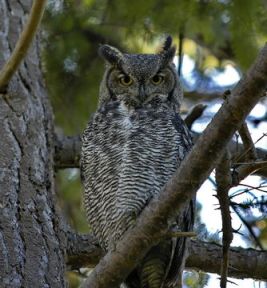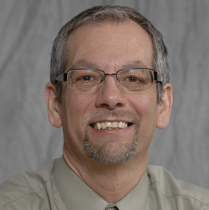The great horned owl (Bubo virginianus) rules the skies over many Nebraska acreages.This predator is commonly seen during winter months when trees have lost their concealing foliage. With a 2-foot body length and a wing span of close to 5 feet, this owl is impressive - especially over a moonlit snow-covered landscape. The great horned owl is slightly larger than a red-tailed hawk. When it sits in a tree or on a barn, its form is that of a classic owl seen in children's books and movies. The great horned owl perches tall with a large round head and big yellow eyes. The long prominent tufts that extend outward from this owl's ears contribute to its common name. The photo by Brendan Lally, eol.org shows the huge yellow eyes and ear tufts. This owl's calls are the deep-throated "who ... who" associated with fairytales. Males usually have a deeper pitched call than females.
This owl is found throughout North America, from the Arctic to the tropics. While it can live in dense woodlands to deserts, it prefers open-forested habitats across Nebraska. Great horned owls seem to select larger older trees, both coniferous and deciduous. During daylight hours of winter months, they hide in large conifers, such as tall cedars, in a mixed forest stand. These typically occur in city parks, making the great-horned owl an urban as well as acreage resident. They have been found perching in barns and on man-made poles at night.
Great horned owls will prey upon almost any animal that they can catch. They will search out frogs and larger insects, in addition to mammals as large as themselves, such as woodchucks, house cats, and geese. However, their most common prey appears to be rabbits, voles, gophers, and starlings in Nebraska. The great horned owl's talon grip has been noted to exert forces greater than 25 pounds of pressure.
Great horned owls form monogamous pairs that defend their nesting site and feeding territories. This behavior is especially prevalent in the winter just prior to egg-laying, and in the early fall when the young are leaving the nest area. Great horned owls have been seen killing their own species to protect nesting sites and young. Usually, a new nest is built each season. The nests are made of large and smaller sticks lined with fur, feathers, and shredded bark.


